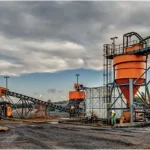An independent audit has revealed that the toxic spill at a Chinese-owned copper mine in Zambia earlier this year may be one of the worst mining disasters in history, releasing 30 times more waste than officially acknowledged.
According to Drizit Zambia Ltd., at least 1.5 million tons of sulphuric acid-laden tailings escaped when a waste dam at Sino-Metals Leach Zambia Ltd. near Kitwe partially collapsed on February 18. This is equivalent to more than 400 Olympic-sized swimming pools of toxic sludge.
The Zambian government and Sino-Metals had initially reported only 50,000 tons, a figure Drizit called “grossly inaccurate.”
Environmental and Human Risks
“This is a large-scale environmental catastrophe threatening drinking water, fisheries, and farmland,” Drizit stated in its June 3 report, seen by Bloomberg.
Early tests on the Mwambashi River, which connects to the Kafue River—an essential source of water for Lusaka and home to one of Africa’s largest national parks—recorded pH levels as low as 1, strong enough to dissolve human bone.
The Zambian government responded by dumping hundreds of tons of lime into the river, bringing acidity back to normal levels. However, experts warn that heavy metals such as arsenic, cyanide, and uranium remain, posing long-term risks to local communities and ecosystems.
Political and Economic Fallout
The disaster threatens President Hakainde Hichilema’s goal of tripling Zambia’s copper output to 3 million tons annually, a cornerstone of his investment drive.
It also comes at a sensitive moment in Lusaka’s relations with Beijing, as Zambia seeks to restructure $5.6 billion in Chinese debt, while China Nonferrous Mining Corp., Sino-Metals’ parent company, has pledged $1.3 billion in new mining investments.
The U.S. Embassy has withdrawn staff from Kitwe and nearby areas. Ambassador Michael Gonzales warned in an internal email that the spill could rank as the sixth-worst mining disaster in history, with consequences that “will be severe and long-lasting” without immediate cleanup.
Dispute Over Findings
Sino-Metals terminated its contract with Drizit, questioning the methodology that relied partly on social media footage and field surveys.
“The dam where the tailings escaped from is still there, and the amount can be determined by the dam’s volume,” a company spokesperson said. “If Drizit calculated spillage using social media footage, that is quite an interesting methodology.”
Drizit countered that Sino-Metals attempted to obstruct its work and influence its conclusions before cutting ties days ahead of the report’s completion.
Official Response
The Zambian government has largely downplayed the risks, with senior officials even drinking tap water on state TV to demonstrate safety. No deaths or confirmed cases of poisoning have been reported, though 800 residents remain in the fallout zone.
Environment Minister Mike Mposha declined to comment.















